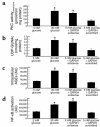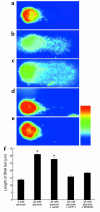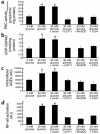Inhibition of GAPDH activity by poly(ADP-ribose) polymerase activates three major pathways of hyperglycemic damage in endothelial cells
- PMID: 14523042
- PMCID: PMC198524
- DOI: 10.1172/JCI18127
Inhibition of GAPDH activity by poly(ADP-ribose) polymerase activates three major pathways of hyperglycemic damage in endothelial cells
Abstract
In this report, we show that hyperglycemia-induced overproduction of superoxide by the mitochondrial electron transport chain activates the three major pathways of hyperglycemic damage found in aortic endothelial cells by inhibiting GAPDH activity. In bovine aortic endothelial cells, GAPDH antisense oligonucleotides activated each of the pathways of hyperglycemic vascular damage in cells cultured in 5 mM glucose to the same extent as that induced by culturing cells in 30 mM glucose. Hyperglycemia-induced GAPDH inhibition was found to be a consequence of poly(ADP-ribosyl)ation of GAPDH by poly(ADP-ribose) polymerase (PARP), which was activated by DNA strand breaks produced by mitochondrial superoxide overproduction. Both the hyperglycemia-induced decrease in activity of GAPDH and its poly(ADP-ribosyl)ation were prevented by overexpression of either uncoupling protein-1 (UCP-1) or manganese superoxide dismutase (MnSOD), which decrease hyperglycemia-induced superoxide. Overexpression of UCP-1 or MnSOD also prevented hyperglycemia-induced DNA strand breaks and activation of PARP. Hyperglycemia-induced activation of each of the pathways of vascular damage was abolished by blocking PARP activity with the competitive PARP inhibitors PJ34 or INO-1001. Elevated glucose increased poly(ADP-ribosyl)ation of GAPDH in WT aortae, but not in the aortae from PARP-1-deficient mice. Thus, inhibition of PARP blocks hyperglycemia-induced activation of multiple pathways of vascular damage.
Figures







Comment in
-
Diabetes, microvascular complications, and cardiovascular complications: what is it about glucose?J Clin Invest. 2003 Oct;112(7):986-8. doi: 10.1172/JCI19902. J Clin Invest. 2003. PMID: 14523035 Free PMC article.
Similar articles
-
Diabetes, microvascular complications, and cardiovascular complications: what is it about glucose?J Clin Invest. 2003 Oct;112(7):986-8. doi: 10.1172/JCI19902. J Clin Invest. 2003. PMID: 14523035 Free PMC article.
-
Poly(ADP-ribosyl)ation: its role in inducible DNA amplification, and its correlation with the longevity of mammalian species.Exp Clin Immunogenet. 1992;9(4):230-40. Exp Clin Immunogenet. 1992. PMID: 1307244 Review.
-
Metformin suppresses high glucose-induced poly(adenosine diphosphate-ribose) polymerase overactivation in aortic endothelial cells.Metabolism. 2009 Apr;58(4):525-33. doi: 10.1016/j.metabol.2008.11.012. Metabolism. 2009. PMID: 19303974
-
Poly(ADP-ribose) polymerase inhibition improves endothelial dysfunction induced by reactive oxidant hydrogen peroxide in vitro.Eur J Pharmacol. 2007 Jun 14;564(1-3):158-66. doi: 10.1016/j.ejphar.2007.02.060. Epub 2007 Mar 12. Eur J Pharmacol. 2007. PMID: 17397824
-
[Poly(ADP-ribose) polymerase-1 as a regulator of protein-nucleic acid interactions in the processes responding to genotoxic action].Mol Biol (Mosk). 2004 Sep-Oct;38(5):834-47. Mol Biol (Mosk). 2004. PMID: 15554186 Review. Russian.
Cited by
-
Extracellular Vesicles and MicroRNA: Putative Role in Diagnosis and Treatment of Diabetic Retinopathy.Antioxidants (Basel). 2020 Aug 4;9(8):705. doi: 10.3390/antiox9080705. Antioxidants (Basel). 2020. PMID: 32759750 Free PMC article. Review.
-
Oxidative stress and epigenetic modifications in the pathogenesis of diabetic retinopathy.Prog Retin Eye Res. 2015 Sep;48:40-61. doi: 10.1016/j.preteyeres.2015.05.001. Epub 2015 May 12. Prog Retin Eye Res. 2015. PMID: 25975734 Free PMC article. Review.
-
Novel modulators of poly(ADP-ribose) polymerase.Trends Pharmacol Sci. 2006 Dec;27(12):626-30. doi: 10.1016/j.tips.2006.10.003. Epub 2006 Oct 19. Trends Pharmacol Sci. 2006. PMID: 17055069 Free PMC article.
-
Responses of retinal and brain microvasculature to streptozotocin induced diabetes revealed by global expression profiling.Diab Vasc Dis Res. 2023 Jan-Feb;20(1):14791641221147533. doi: 10.1177/14791641221147533. Diab Vasc Dis Res. 2023. PMID: 36606460 Free PMC article.
-
[Heart failure in diabetes].Wien Med Wochenschr. 2009;159(5-6):134-40. doi: 10.1007/s10354-009-0645-0. Wien Med Wochenschr. 2009. PMID: 19343290 Review. German.
References
-
- The Diabetes ControlComplications Trial Research Group. The effect of intensive treatment of diabetes on the development and progression of long-term complications in insulin-dependent diabetes mellitus. The Diabetes Control and Complications Trial Research Group. N. Eng. J. Med. 1993;329:977–986. - PubMed
-
- UK Prospective Diabetes Study (UKPDS) Group. Intensive blood-glucose control with sulphonylureas or insulin compared with conventional treatment and risk of complications in patients with type 2 diabetes (UKPDS 33). UK Prospective Diabetes Study (UKPDS) Group. Lancet. 1998;352:837–853. - PubMed
-
- Wei M, Gaskill SP, Haffner SM, Stem MP. Effects of diabetes and level of glycemia on all-cause and cardiovascular mortality. The San Antonio Heart Study. Diabetes Care. 1998;21:1167–1172. - PubMed
-
- Brownlee M. Biochemistry and molecular cell biology of diabetic complications. Nature. 2001;414:813–820. - PubMed
-
- Nishikawa T, et al. Normalizing mitochondrial superoxide production blocks three pathways of hyperglycaemic damage. Nature. 2000;404:787–790. - PubMed
Publication types
MeSH terms
Substances
LinkOut - more resources
Full Text Sources
Other Literature Sources
Medical
Research Materials

